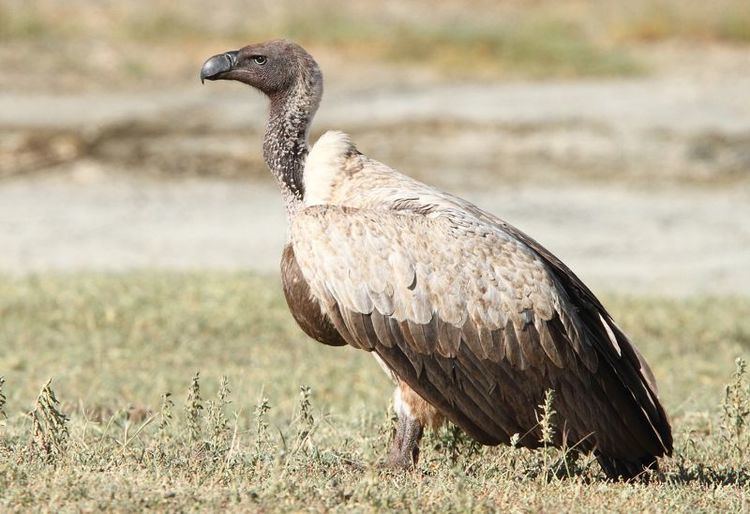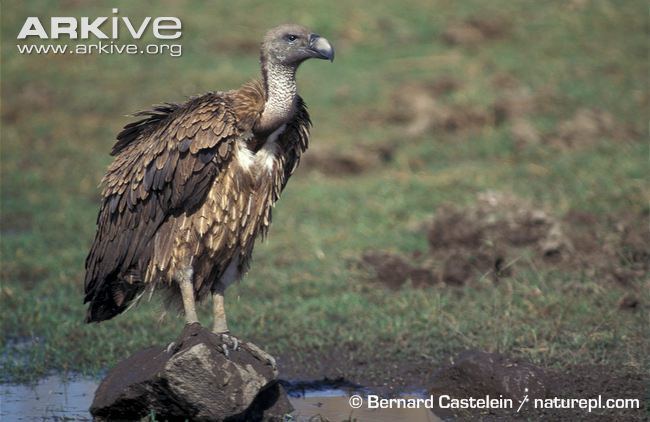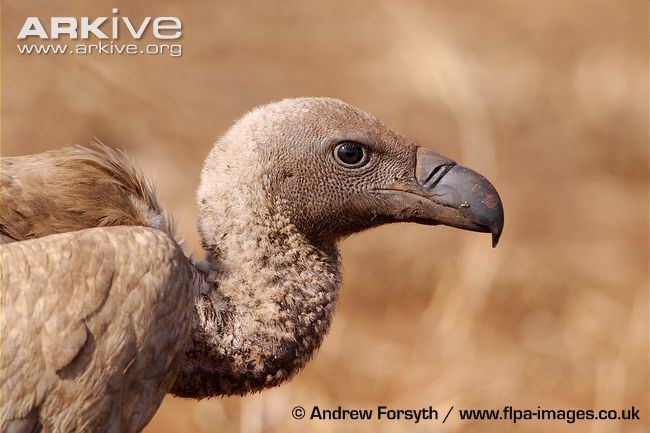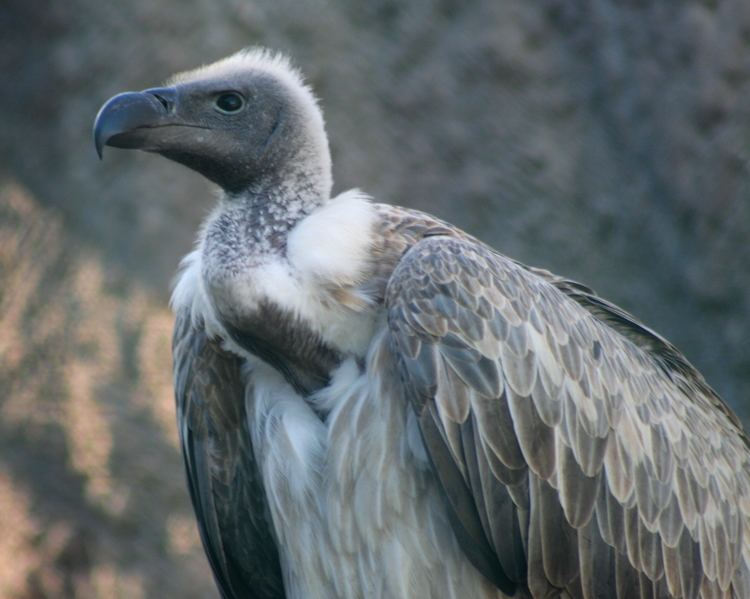Higher classification Gyps | Phylum Chordata Scientific name Gyps africanus Rank Species | |
 | ||
Similar Bird, Gyps, Lappet‑faced vulture, Rüppell's vulture, Hooded vulture | ||
The white-backed vulture (Gyps africanus) is an Old World vulture in the family Accipitridae, which also includes eagles, kites, buzzards and hawks. It is closely related to the European griffon vulture, G. fulvus. Sometimes it is called African white-backed vulture to distinguish it from the Oriental white-backed vulture — nowadays usually called white-rumped vulture — to which it was formerly believed to be closely related.
Contents

The white-backed vulture is a typical vulture, with only down feathers on the head and neck, very broad wings and short tail feathers. It has a white neck ruff. The adult’s whitish back contrasts with the otherwise dark plumage. Juveniles are largely dark. This is a medium-sized vulture; its body mass is 4.2 to 7.2 kilograms (9.3–15.9 lb), it is 78 to 98 cm (31 to 39 in) long and has a 1.96 to 2.25 m (6 to 7 ft) wingspan.

Like other vultures it is a scavenger, feeding mostly from carcasses of animals which it finds by soaring over savannah. It also takes scraps from human habitations. It often moves in flocks. It breeds in trees on the savannah of west and east Africa, laying one egg. The population is mostly resident.

White backed vultures mating in the klaserie
Endangerment

As it is rarer than previously believed, its conservation status was reassessed from Least Concern to Near Threatened in the 2007 IUCN Red List. In 2012 it was further uplisted to Endangered. In October 2015, its status was changed to Critically Endangered because the ongoing decline is more severe than previously thought.

The population size of the white-backed vulture has been decreasing significantly within the past few decades. In 1922, the population was estimated at 270,000. Over the past two decades, its population has noticeably decreased. While not much is known about the current population, a recent study found that white-backed vultures have a high survival rate. Individual adults have the highest survival rate, while 2 year old birds have the lowest survival rate. Across all ages, the survival rate is estimated to be 90.7%. This means that the deaths of adult vultures will lead to rapid population declines. The loss of adults will cause less reproduction and with younger birds less likely to survive, the population will drop drastically. A major cause of population decrease is the loss of habitat. Elephants have been endangering the vultures, since they destroy the trees the vultures live and nest in. Vultures tend not to nest in areas with high elephant populations.Fires have also caused the destruction of trees. Humans also have a large impact. Our power lines have caused many vultures to be electrocuted. In Kenya especially, humans are using a very toxic pesticide called Furadan, which has led to many vulture deaths. Vultures are also being poisoned by humans, although not intentionally. In order to kill hyenas, lions, and other predators, herders add poisons into their livestock. Vultures ingest the poison upon eating a deceased animal's carcass. This poisoning generally occurs outside of protected areas, but is a leading factor in the population’s decline. Habitats are being also disturbed by human land management and direct nesting persecution patterns.
More recent studies have indicated a new plausible factor in the current declination of the vultures. Researches have seen that there has been a rise in toxicity in the liver, kidneys, pectoral region, and internal organs. This toxicity is caused by higher levels of lead, cadmium, zinc, and copper. Although most of these metals level out as either non harmful or normal levels, the lead concentrate in the liver of the vultures (8.56 µg/g wet weight) and in the kidneys (9.31 µg/g wet weight) is higher than the average levels.
Studies have also been performed on the white-backed vulture and some species of Asian vultures within the Gyps clade to see the effect of veterinary diclofenac. Regardless of whether the vultures were given an oral or intravenous dose of the substance, the effects was nearly identical and the diclofenac eventually poisoned the subjects. This chemical is one of the greatest contaminants for the general vulture population because of its presence in livestock: easy food for the vultures.
Another study shows that there are heightened levels of polycyclic aromatic hydrocarbons, HPA’s, which isn’t as likely a product in the endangerment resultant, but still concerning. HPA’s, also known as polyaromatic hydrocarbons, are formations of hydrogen atoms surrounding rings of carbon. As common as these compounds are—found in foods, engines/incinerators, fires, combustion—there are many forms, and some carcinogenic. Although there is no direct correlation of the high levels of HPA’s in the vultures, there is still a plausibility that it can result in a negative outcome for the species.
Diet
White-backed vultures are an endangered species, and they need all their resources in order to survive. One trait that the vultures have is their vocalization when it comes to eating. White-backed vultures give out a yell when they are locked onto a target or even when they are eating. These creatures are in great danger though, as they have been slowly disappearing. It does not help their survival rate with a diminishing environment, causing a decrease in the amount of food available, and then the competition for food. The competition affects the vultures in a variety of different ways. First, the white-backed vulture is not a species that shares food with others of its own species. Second, there is the competition that the white-backs face with other animals in their habitat. It is just not what the vultures eat that is a huge part to their diets.
The main food source of the creature is eating the remains of the dead bodies around its habitat or home. The creature lives in Africa, in the Savannah, so it will either soar around in the sky or from some trees in this grassland area, or even wooded areas. The vulture will also follow the water streams during the wet season in the Savannah, this is an ideal place to find food, as other animals are gathered to get water. Some examples of what a white-backed vulture would actually eat are warthogs, zebras, gazelles, or ostriches, but it will basically feast on any animal.
